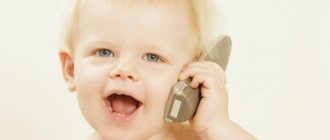Three years is the age of endless “whys.” Usually, parents have to answer numerous questions from their baby without stopping. However, there are children who stubbornly remain silent until this age. It is not surprising that frightened parents are interested in only one question: “When will he speak?”
Article on the topic Everything is silent and silent. Why does a child have a speech delay and what to do about it?
Answered by speech therapist-defectologist of the highest qualification category of the Center for Reproduction and Family Planning Olga Komarova .
The concept of “norm” in modern speech therapy is quite vague. It is seriously different from the standards that existed 20-30 years ago. Today it is believed that simple phrasal speech (“I’m thirsty,” “let’s go for a walk,” etc.) should appear in a child by the age of one and a half to two years.
In the period from 2 to 3 years, the active vocabulary usually expands, and two-part sentences appear. At this age, the child constantly voices his play.
By age 5, a child should be able to use complex sentences. Slight violations of the grammatical structure of speech are allowed. Children at this age need to be taught to retell simple fairy tales (“Turnip”, “Kolobok”) and to know short rhymes.
Before school, a child must be able to pronounce all sounds correctly, distinguish words that sound similar in sound (phonemic hearing), be able to form and modify words, make sentences, use prepositions correctly and not confuse them. If a preschooler can retell simple texts, put letters into syllables, and is familiar with the alphabet, then there should be no problems at school.
But this is an ideal scenario. In practice, all children develop at different rates and are more or less talkative.
However, if a child is silent before the age of 3, you need to sound the alarm.
Trauma, stress and excess information. Why do people start to stutter Read more
Strictly on schedule?
Many parents believe that a speech therapist should be contacted only when the child has obvious speech problems. However, there are symptoms that appear long before such problems become apparent.
The child should undergo the first scheduled examination by a speech therapist at two years of age. However, if parents are concerned about something, it is better to show the baby to a specialist as early as possible.
The reason for contacting should be the delay or absence of humming (the same “aha” that ideally should appear at 3-4 months) and babbling (at 5-6 months).
You should be wary if a child does not respond to the parents’ voice: this may indicate both hearing problems and serious mental disorders. Normally, the baby should react to any sound: turn around or look for its source with his eyes.
It is important that “gibberish” (infant speech) appears on time (at 8-9 months). The constant babbling of a child, which intensifies when communicating with adults, is the best option, which indicates that speech development is going according to plan.
There are other problems that at first glance are not related to speech, but in fact go along with it. Pay attention to how your child chews food. If the baby chews poorly, holds food in his mouth for a long time, or chokes on it, this may indicate disturbances in the innervation (connection of nerve fibers with a specific organ responsible for a particular function) in the area of the articulatory apparatus.
A constantly open mouth and drooling incessantly (hypersalivation) can also indicate dysarthric problems (weak muscles of the organs of articulation). By the way, you can get rid of this problem quite quickly with the help of a special speech therapy massage.
Article on the topic
It's time to go to school? Is the child ready to study?
Speech development from 0 to 12 months
A pediatrician and a pediatric neurologist evaluate the baby’s development in accordance with existing standards:
- by 6 months the child begins to babble and coo;
- per year can pronounce a few simple words.
But the child’s development does not always correspond to the “standard”. A number of factors influence when a baby learns to speak:
- the course of pregnancy and childbirth;
- education methods;
- gender
In most cases, girls start talking earlier than boys. And speech defects are diagnosed more often in boys. Genetic determination is also important: if relatives suffered from speech disorders, then the risk of their occurrence in the child increases.
The reason to contact a speech pathologist is a 1.5 year old child’s inability to understand simple words and a complete lack of speech at 1.9 years old.
Many parents are proud that a year and a half year old child speaks in long sentences and has a large vocabulary. But this is too much of a burden for the baby’s unformed nervous system. You should walk more with your child in the fresh air, relax, and minimize the information flow.
Communication and massage
What can parents do at the “toothless” age so that the child speaks correctly in the future?
Firstly, parents need to spend as much time as possible with the baby, communicate and play with him. Moms and dads must remember that the main source of the harmonious development of the child is themselves.
The baby learns when he sees everything his parents do and repeats their movements. Therefore, you need to comment on what is happening and explain your actions, draw the child’s attention to the details (“it’s raining outside: drip-drip”, “how the leaves rustle: rustle-shur”, “now I’ll take the milk out of the refrigerator, how cold it is!”).
The child may not understand the words, but he will see the movement of the lips and the emotions that appear on the face (face-to-face communication is the best way to interact with the child). In this way, the baby’s passive vocabulary will accumulate, which in the future will become active. It can be recommended to massage the child’s articulation organs (cheeks, lips, tongue) daily in a playful manner. It is better to do this with warm hands or cotton swabs with soft, unobtrusive movements. While performing such a massage, you need to tell a fairy tale or nursery rhyme to your baby.
Five advantages of a grandmother. A nanny will not replace communication with older relatives Read more
How to properly develop speech in a baby
Authors : Koval Irina
Until recently, you had a completely different life, the center of which was yourself, your desires, your aspirations, your needs. But a miracle happened - a new life was born, and everything started spinning, spinning, working, obeying some of its incomprehensible laws. New sensations, restructuring of the body, hormones, fears, worries, endless tests, doctors, medications, maternity hospital, contractions, childbirth, and, finally, the long-awaited meeting - the main miracle of life, the new center of the universe: your baby, snoring in your arms. Pleasant fatigue, indescribable delight and happiness, and it seems that the hardest part is behind us.
But in reality, everything is just beginning. Now your life is subject to the needs and desires of the baby - the dearest, most beloved, most desired person, and yet the most incomprehensible to you. Incomprehensible crying, incomprehensible runny nose, incomprehensible temperature, incomprehensible appetite, incomprehensible sleep - absolutely everything is incomprehensible and frightening!
However, days full of troubles and sleepless nights, the help and care of loved ones, and most importantly, your boundless love work wonders. And now your child becomes your dearest, you feel his every breath, hear his every sob and know absolutely everything about him - what he needs, what he wants now, what he wants in a minute. Advice from wise grandmothers, recommendations from doctors, information from books, magazines, and the Internet help you become the best specialist in the field of child development, the best for your baby. And it is very important for you to know when, what, and to what extent your little one should do in order to grow up as a healthy, smart and happy child.
With close attention, under constant supervision from grandparents, neighbors and the local pediatrician, you strictly monitor when the baby raised his head, when he turned on his tummy, when he sat down, when his first tooth came out, when he took his first steps on the way to independent life. Make sure you help in time and don’t miss something serious... And this is really right, because every achievement of a child becomes a necessary foundation, a basis for his further “exploits.” And there is absolutely no time to linger! In just one year, a small squeaking lump turns into a smart fidget with its own interests, needs and an insatiable thirst for new knowledge, skills, and discoveries.
And if with motor and physical development everything is more or less clear and visual, then the intellectual, in particular speech, development of a baby in the first year of life is fraught with many mysteries, but is of enormous importance for his happy future.
Where to begin
The baby was born. From something so familiar, reliable, familiar, and warm, I was born into something cold, noisy, bright, and terribly incomprehensible. And the most important thing now is that you feel warm, nourished, calm and smell like mom again. And the baby screams. At first he screams because it’s scary and unpleasant, and then - so that it becomes calm and satisfying.
Days, weeks, months pass. Mom is nearby, almost always dry and comfortable, and it’s almost not scary at all. And it turns out there are so many interesting things around! But so far little is visible. Therefore, you need to turn around, look more closely and listen! There are so many different sensations, images and different sounds, and the most pleasant of them is the mother’s voice, because it means that she is nearby - with her dry diapers, with her warmth, with her milk, with her hugs, with her love. The baby, like a sponge, absorbs all the colors, all the smells, all the sounds, all the sensations that the world around him is rich in. And this is the most valuable luggage that a little man acquires. This is the foundation for the house, for the structure called “personality”!
The more sensations, the more varied they are, the faster the baby moves further in his development. Based on the impressions received, the first conclusions are drawn, images and concepts are formed, and the first classifications are carried out. And this is a huge, colossal work for the baby, an incredible amount of strength and energy is spent on this, because this is his most important task now - to learn about this world in order to adapt to it, adapt, survive.
And the very first, most important conclusion that the baby makes is that it is impossible to learn anything, it is impossible to get used to the outside world, it is impossible to survive without an adult, without the person directly caring for him. The baby distinguishes this person from the general flow of sensations, remembers his face, his voice and tries to make the first contacts. The first smiles, the first movements, the first sounds addressed to a certain person - this is the beginning of the beginning, the first experience of communication. And if the baby receives everything he needs from an adult, if all his needs are satisfied, and he is firmly confident in the future, and any annoying sensations like swollen gums or a grumbling tummy are not too distracting, then the time of great discoveries comes.
The first step to speech
For us, adults, everything is already simple and clear: we pronounce different sounds, sounds form words, words denote objects, actions, phenomena from the surrounding world. And for a child this is real magic, the discovery of America. And a child can discover this “America” only for himself, thanks to his own activity, his own activity. And the first thing a child can do is cry. In this matter, over time, the baby becomes a real virtuoso; with the help of crying alone, he can not only express his feelings, desires, his attitude to what is happening around him, but also cleverly manipulate adults. A little time passes, and the first speech sounds are born in crying. So far they have little resemblance to human speech, but this is a new, very important stage of speech development, called humming.
The baby discovers the wonderful world of sounds, plays with pleasure, experiments with them, thus training the speech apparatus, gets to know himself, his capabilities, and the world around him. At the same time, the child learns to listen, to identify speech sounds in the general flow of sensations. And this is the basis for the development of phonemic processes, without which speech is simply impossible. During this important period of life, the child needs an adult, a master wizard, a role model, and a powerful stimulus for speaking, more than ever. It helps turn sounds into words, into song, into love, into care.
And to make an adult smile, the baby moves on to the next discovery - it turns out that sounds can be combined into syllables! the babbling begins . How much tenderness there is for adults, how much delight there is for a chatterbox, and how much benefit for the speech apparatus and mental development in general! Especially when this is not a monologue, but a real dialogue: the adult repeats everything after the baby, while forming random syllables into words. And all this with a smile, in a good mood, with clear articulation. At the same time, not forgetting about the passive vocabulary (understanding of words denoting objects, people from the baby’s immediate environment), for which purpose many times clearly naming everything that the baby sees, plays with, and is interested in.
Constant speech “training”, a life rich in impressions, active support from adults, and here it is, the long-awaited result - the first full words , the most important, the most important in life: DAD, MOM, GIVE! But you can’t stop! There are so many interesting things ahead that need to be discovered, learned, conquered... Only together!
Conditions for development
Once again I would like to emphasize that the development of a baby’s speech begins from the first days of his life. This is the pre-verbal stage of speech development - it is still far from the first words, but the baby is already working hard: pronouncing the first sounds, syllables, listening to adults, communicating... This is how the foundations of phonemic processes are laid - the child learns to hear speech sounds, words, understand the names of others objects, phenomena.
Therefore, for the successful speech development of a baby in the first year of life, the following is necessary:
- a healthy, well-fed, dry, well-slept, happy child;
- a healthy, well-rested, satisfied parent;
- direct (without TVs, phones, dirty dishes), eye-to-eye emotional communication between an adult and a child;
- the surrounding world (sounds, colors, sensations - the more varied, the better, the main thing is that everything is adequate for the baby - not very loud, not very bright, pleasant and comfortable);
- and most importantly - faith in yourself, the best parent, and faith in the baby, the best in the world.
published 12/25/2019 18:18 updated 12/25/2019 — Growth and development, Speech development
Silence is gold?
Speech delay up to 3-4 years can be caused by a variety of reasons. Finding them out is the task of the speech therapist. Contrary to popular belief, most speech delays are not associated with serious problems. Sometimes the reason lies not in the child himself, but in the family situation, which at first glance may seem quite prosperous.
For example, a mother stays at home with her baby. Formally, they are together all the time, but in fact, the mother does household chores, and the child sits in a crib or playpen. The worst thing is if the mother gives the baby a gadget during this time. Electronic toys are the scourge of our time. It has been proven that they have a bad effect on the nervous system and speech development. Therefore, pediatricians and speech therapists have an unspoken rule: under 3 years of age, a child should not watch TV or play with electronic toys.
Sometimes it is allowed to watch a cartoon together with an adult with discussion and comments. You can often hear at a reception: “Our TV is working, but the child doesn’t watch it.” But the background mode “clogs” the baby’s perception centers, which should be aimed at assimilating other sounds. The child simply does not hear them, constantly being distracted by changing frames and loud advertising. You shouldn’t delude yourself about educational computer games (and today even 0+ games have appeared). The best development for a child is communication with his mother, family, and other children. No fancy computer toys can replace it.
Question answer
How to get children to read?
When should a child start talking?
There are norms of speech development that can be used to understand whether the baby is developing normally or has deviations.
- By the age of 1 year, most children meaningfully say several words: “mom”, “dad”, “baba”, “beep-beep”, “woof-woof”, “pee-pee”. Until the age of one and a half, children speak in one-word sentences.
- At 1.5 - 2 years old, the baby’s vocabulary expands, he begins to say words consisting of several syllables: “car”, “grandmother”, “swing”. The child names close people and describes objects and actions. The baby develops a need for communication. He accompanies his play activities with speech, and is surprised to discover that all the objects around him have their own names. This age is characterized by active speech development and determines a qualitative leap in the child’s development. Gradually, the baby begins to imitate not only the words of adults, but also their phrases. The vocabulary is actively developing, which by the age of 2 years is about 300 words.
- At 2 years old, the child masters the pronunciation of sounds, the grammatical structure of sentences, and continues to expand his passive and active vocabulary. A characteristic feature of the speech of two years is that it is gestural: consisting of facial expressions and sounds. When asked by an adult, the child not only makes sounds, but also accompanies his answer with facial expressions.
- By the end of the second year, children's vocabulary is 200-400 words. At the same time, the baby pronounces many words incorrectly, distorting them, replacing some syllables with others: “hoe” instead of “hat”, “pipitalet” instead of “pistol”. However, by the end of the second year of life, the baby begins to use his speech as a means of communication with others, primarily with adults. A two-year-old can turn to his parents with a request, express his emotions to them, and actively express his desire or unwillingness to do something.
How to make a silent person talk?
I would like to warn parents against a common mistake. It is known that children who understand everything but say nothing are called silent. However, when such kids ask to give them something and point to an object, parents pretend that they do not understand and ask to explain in words. This behavior hurts the baby. He ceases to trust his parents and perceive them as “his own.”
You need to understand that the child is silent not out of “harm,” but because some problem prevents him from speaking (for example, incorrect perception of sounds). Experts recommend a different technique.
You need to read poems well known to the child and sing children's songs without saying the ending. The brain is designed in such a way that it always strives to complete a melody or poem if it ends on an unstable note. Therefore, the baby will certainly have a need to finish what he heard.
Melodies that end on open syllables are very useful for speech development. For example, the famous song “Far, far away, in the meadow they are grazing…”, where the parent will sing only the first two syllables of the word “far”, and the child will finish.
Komarovsky on the development of speech function
Dr. Komarovsky is a pediatrician who became famous thanks to his programs. In them, he gives recommendations to parents on children's health and education. In television programs, the doctor spoke more than once about the development of speech.
Komarovsky talks about the importance of a child’s communication with parents and people around him. According to him, the baby develops correctly when parents are present during the game. Adults help him explore the world. During communication, mom or dad teach how to throw a ball, what to do with a pyramid, and so on, and give a task (instructions). Example: “Take the ball and bring it to mom,” “Throw the ball to dad.”
While playing together, the baby learns to listen and analyze the parents’ speech. He has a desire to learn to speak, pronounce words correctly, construct phrases and sentences. This is very important, especially at the stage of transition from understanding the oral speech of others to reproducing it independently.
Grammatical structure of speech and sound pronunciation
After one and a half years, the ability to change words in the simplest ways appears, linking them into one phrase (give me a doll - “give me a ku”). Monosyllabic sentences are most often used. In such primitive sentences, one word can be used in different meanings. By pronouncing the word “mu,” in one case the child wants to be given a toy, and in another, with the same word, he draws the adult’s attention to the eyes or horns of the toy cow that he is holding in his hands.
By the end of the second year of life, sentences may contain three or four words. Sentences can be both interrogative and exclamatory. The question words themselves are not yet available to the child; he expresses the question by the intonation with which he pronounces such a sentence. There are no prepositions in the words yet either (“Seva bi-bi” - Seva has a typewriter).
All vowel sounds are already pronounced by the baby in the second year of life. Its articulations and some consonant sounds are available: m, p, k, t, d, n, f, x, b, g, v, y. The clarity of their pronunciation depends on the place of the sound in the word and the number of syllables in it. In simple words of one or two syllables, all sounds are pronounced correctly (Katya, dad, Tanya, Vova). These same sounds are “swallowed” and distorted in more complex words (pisina - machine). Combinations of two consonant sounds next to each other (heb - bread) are also difficult for the baby, especially if these are sounds that are difficult to pronounce, for example: s, sh, r, l.
Different rates of speech acquisition by children of the same age become noticeable. This depends on the individual characteristics of the baby, heredity, and diseases suffered in early childhood. Of great importance is the intensity of communication between adults and the child, how the child’s speech development is stimulated at 1 year of age.









